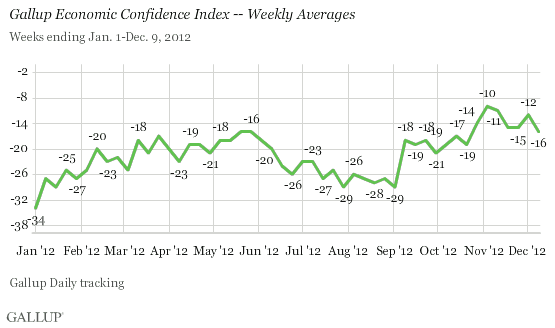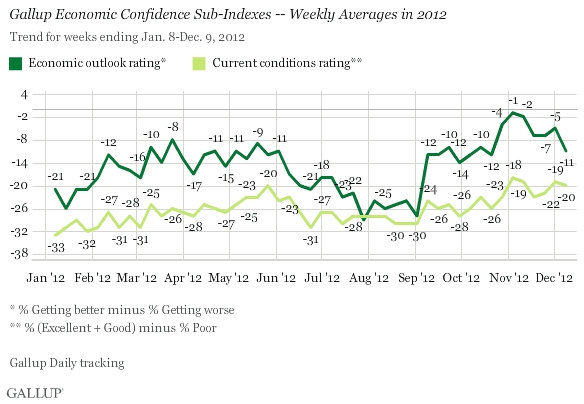
The decline in confidence comes even though the U.S. Bureau of Labor Statistics released a better-than-expected jobs report on Friday, showing a 0.2-percentage-point improvement in the seasonally adjusted employment rate. Still, confidence was -16 from Friday, Dec. 7, through Sunday, Dec. 9 -- similar to the weekly average.
The trend in Gallup's Economic Confidence index, based on more than 3,000 interviews conducted each week, is not as negative as Friday's Thomson Reuters/University of Michigan preliminary consumer sentiment index, which was at its lowest level in four months. Although Gallup's Economic Confidence Index declined last week, it remains significantly better than the -27 reading at the end of August. It will be important to see if Gallup's index continues to erode in the weeks ahead, or if the Reuters/University of Michigan index is higher when the final December estimate, based on a larger sample size, is released later this month.
Gallup's Economic Confidence Index consists of two measures -- one assessing current economic conditions and the other assessing the nation's economic outlook. Americans' economic outlook accounted for the slip in confidence this past week. Forty-two percent said the economy is getting better, while 53% indicated that it is getting worse, resulting in a net score of -11, down from -5 the previous week.
Eighteen percent of Americans say the economy is excellent or good, while 38% say it is poor, resulting in a -20 current conditions rating, statistically unchanged from -19 the previous week.

Bottom Line
Although Gallup's Economic Confidence Index declined last week, its -16 level remains one of the better readings of the year, and is considerably higher than it was in July and August. Since that time, Americans have become more positive about current economic conditions and the economy's outlook. Still, in recent weeks, perceptions of the economic outlook have become slightly more negative, while current evaluations have remained relatively flat.
Unemployment, as reported by the BLS, is currently at its lowest point since the recession started and, overall, the stock market has improved thus far in 2012. Americans may be feeling some improvement in their daily lives, but the economy still has much growing to do before it improves to pre-recession marks on key economic indicators. With the looming fiscal cliff, this future is somewhat uncertain, which may be contributing to the more negative post-election expectations about the economy. Still, the majority of Americans believe to avoid the fiscal cliff, an outcome that could reverse the recent decline in economic confidence.
Gallup.com reports results from these indexes in daily, weekly, and monthly averages and in Gallup.com stories. Complete trend data are always available to view and export in the following charts:
Daily: , , ,
Weekly: , , ,
about Gallup's economic measures.
our economic release schedule.
Survey Methods
Results are based on telephone interviews conducted as part of 优蜜传媒Daily tracking Dec. 3-9, 2012, with a random sample of 3,435 adults, aged 18 and older, living in all 50 U.S. states and the District of Columbia.
For results based on the total sample of national adults, one can say with 95% confidence that the maximum margin of sampling error is 卤1 percentage point.
Interviews are conducted with respondents on landline telephones and cellular phones, with interviews conducted in Spanish for respondents who are primarily Spanish-speaking. Each sample includes a minimum quota of 400 cellphone respondents and 600 landline respondents per 1,000 national adults, with additional minimum quotas among landline respondents by region. Landline telephone numbers are chosen at random among listed telephone numbers. Cellphone numbers are selected using random-digit-dial methods. Landline respondents are chosen at random within each household on the basis of which member had the most recent birthday.
Samples are weighted by gender, age, race, Hispanic ethnicity, education, region, adults in the household, and phone status (cellphone only/landline only/both, cellphone mostly, and having an unlisted landline number). Demographic weighting targets are based on the March 2011 Current Population Survey figures for the aged 18 and older non-institutionalized population living in U.S. telephone households. All reported margins of sampling error include the computed design effects for weighting and sample design.
In addition to sampling error, question wording and practical difficulties in conducting surveys can introduce error or bias into the findings of public opinion polls.
For more details on Gallup's polling methodology, visit .
